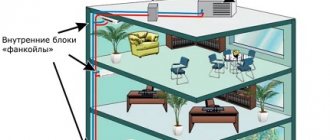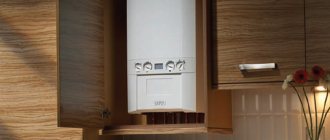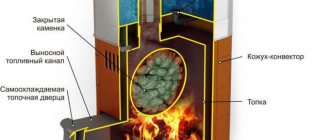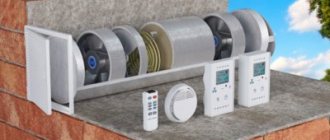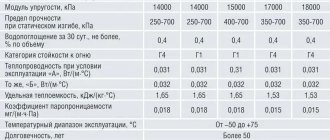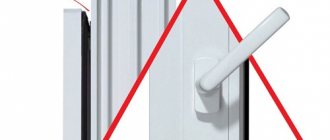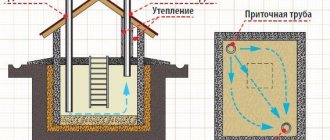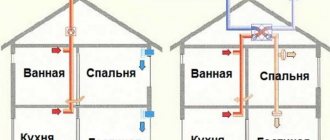In what cases is supply ventilation with air heating used?
Supply ventilation is different in that it takes air from outside, unlike most air conditioning systems. As a result, the air is not only cooled or heated, but also enriched with oxygen. Supply ventilation with air heating is used in those rooms where clean and warm air is constantly needed.
It can work perfectly in an apartment, in a private house, and in a production facility. The special design does not allow mixing of exhaust air from the room and fresh heated air. This is both an air purification and heating system. A heated supply valve to the wall is most often installed in apartments and private houses where there are plastic windows, since natural ventilation is impossible with them.
Types of supply ventilation
Modern supply ventilation schemes are divided into several types:
- Window inlet valve
Natural. In this case, the influx of fresh air is carried out through the cracks in the window frames, between the door leaf and the frame, or through ventilation grilles and channels provided for in the project. The main feature of the natural supply system is the absence of any mechanical drives that force the external air into the room.
- Artificial. These schemes involve the use of ventilation devices, through which external clean and oxygen-rich air is delivered into an enclosed space.
Artificial (or forced) ventilation , in turn, is classified according to the following criteria:
1. By the presence or absence of air ducts.
There are two main schemes for implementing forced supply ventilation: ductless and ducted.
Ductless is used in most cases in individual rooms with low requirements for air purity and the efficiency of cleaning systems. It is a hole in the outer wall, equipped with a grill and mosquito net and equipped with an electric fan that forces air into the room.
The duct system is much more complex. It consists of several air ducts that supply outside air to several rooms or evenly distribute the influx over one large room. At the input of this circuit there is usually a powerful blower fan, an air filter and a heating and/or cooling element.
With the latest devices, this system is classified as climate control, since in addition to air exchange it allows you to maintain optimal temperature conditions inside the room.
2. According to the design of the ventilation network. Based on this parameter, civil, industrial and public supply ventilation networks are divided into:
- Monoblock. Such schemes provide for the installation of one unit at the inlet of the main air duct, in which “everything is included”: forced ventilation equipment, an incoming air heater, a filter, and, if necessary, a cooler and a humidifier. This unit is also equipped with all the necessary automatic control and protection, and is equipped with special sound insulation.
- Prefabricated. Such systems can cover apartment buildings, multi-story buildings or large industrial premises. In turn, prefabricated networks are divided according to the manufacturing method into plastic, metal (stainless steel or aluminum), concrete, plasterboard, pipe and many others. They can be either rectangular or round.
3. According to the ventilation method:
- Local. These schemes are designed to provide inflow into one specific room, that is, they usually refer to ductless systems.
- Complex. The organization of such an exchange scheme involves the presence of a multifunctional unit or separate devices that provide heating of external air in winter, cooling it during hot periods, filtration from mechanical (in some cases, biological) impurities and humidification.
- Emergency (anti-smoke) supply systems are designed to reduce the likelihood of smoke accumulation and fire spread in evacuation areas and in other significant areas of objects. They are only effective in conjunction with an efficient exhaust system.
- Regenerative. In this case, the concept of “recovery” implies heating the incoming air with outgoing warm air. That is, there is practically no energy loss. Only to implement this scheme will require a rather expensive device - a recuperator, in which the heat exchange of the inlet with the air outlet is carried out. But this device, despite its high cost, pays for itself quite quickly, because only 150–200 kW per day is required to heat a well-insulated room. A recuperative ventilation system is especially necessary for modern buildings equipped with practically sealed metal-plastic windows and doors.
How to arrange ventilation in the bathroom and toilet? Select and install an exhaust fan. How to install an air conditioner yourself? Step-by-step instructions, rules for using the device.
Types of systems
The supply ventilation unit with air heating is available in several types. This can be central ventilation, which will heat a large industrial premises, or an office center, or it can be individual, for example, in an apartment or in a private house.
In addition, all heated ventilation systems are divided into the following types:
- With recovery. Essentially, this is a heat exchange system when incoming masses come into contact with outgoing masses and exchange heat. This option is suitable only for regions with not very cold winters. These systems belong to passive ventilation schemes. It is best to place them near radiators.
- Mermen. This heated air supply operates either from a boiler or from a central heating battery. Its main advantage is energy savings. Supply ventilation with water-heated air is especially popular among consumers.
- Electrical. They require quite significant electricity consumption. According to the principle of operation, it is a simple electric heating element that heats the air with its constant movement.
Before choosing one specific model, it is recommended to sit down and calculate how much electricity you will have to spend to heat your apartment or private house.
Supply ventilation may also differ in the method of pumping air into the room. There are natural options, and there are forced ones, when air is taken in using fans. The types of ventilation also differ according to the type of control. These can be manual models or automatic ones, which are controlled using a remote control or from a special application on the phone.
We recommend that you read: How to organize an exhaust air exhaust system in a wooden house
Construction and elements
The design of the air supply unit with a water heater can be either monoblock (the so-called compact air supply units with a water heater, when all the elements are in a single housing), or stacked or sectional type (each component has its own housing and these housings are sequentially connected to each other using fasteners).
The housing of the air handling unit with a water heater can be either simple, that is, without heat and sound insulation, or heat-insulated and sound-insulated.
The fan impeller can have a V-belt drive (recently used less and less), or a direct fit on the engine axis.
A water-heated supply unit may include some of their elements, each of which plays its own role:
- fan - a device that moves air flow, i.e., supplies it from the street to the premises served.
- Heater – serves to heat the external air flow using hot water (water supply unit).
- Cooler - used to cool the fresh air flow using freon or water.
- Air filter - serves to clean fresh outdoor air from dust particles, odors and even germs.
- Silencer - needed to reduce the noise that inevitably appears during operation of the air handling unit.
- An air valve with a servo drive is needed to shut off the air flow to the ventilation machine.
- Humidifier – necessary to increase the humidity in the room.
- Bactericidal section - used to disinfect the supply air from germs (see catalogue).
- Automation system - serves to automatically maintain user-specified parameters (this is a control unit or cabinet, remote control, sensors, relays, drives, speed controllers, mixing unit, etc.)
Principle of operation
Heated supply ventilation is very simple in operating principle. At the first stage, air is drawn in through the air intake and filtered from large debris and insects. After this, air is transferred directly to the device body.
At the next stage, the incoming air is specifically purified from all small particles. To do this, there are several thin filters in the inlet for varying degrees of purification.
After thorough cleaning, the air flows directly to the heating elements. If the device has the ability to control heating, then it occurs only within the specified parameters. After heating, another cleaning process starts, during which the air is freed not only from dust, but also from pollen, other allergens and odors.
As a result, purified and sufficiently warm air enters the room, the temperature of which can be controlled from the control panel.
Parts that make up the ventilation system
Supply ventilation with air heating for an apartment includes several main parts on which the quality of operation of the entire system depends. Such details include:
- Air filter.
- Shut-off valve.
- Heater.
- A fan that blows air.
- Noise muffler. It makes the entire device operate as quietly as possible.
The most important parts in the supply ventilation are the air (shut-off) valve, the filtration element and the heater. With the help of an air valve, air will enter the ventilation only when necessary. Filtration cleans all incoming air as much as possible and prevents dust particles from entering the house.
Thanks to the fan, air enters the room from inside. If the device is turned off, air intake will not take place.
Based on the principle of operation and its characteristics, a heated air supply for an apartment is not suitable for those rooms where there is too much moisture and gas is constantly formed. Therefore, it is better not to hang the vent in the kitchen and bath.
We recommend that you read: Construction and installation of ventilated facades made of porcelain stoneware
Heating of influent masses using recirculation
An obligatory component of ventilation is an electric heater.
Ventilation with heating due to recirculation, speaking in general terms, works according to the following principle:
- air enters the house through the influx of the ventilation system;
- after a certain period of time, it enters the exhaust system, where part of the incoming air masses is removed outside the house;
- the remaining air enters the mixing chamber.
In the mixing compartment, fresh air is mixed with “exhaust” air, thus heating cold wind masses (if the system in the control settings is set to air heating mode, and not vice versa). Next, the air flow is directed to the heater or air conditioner, then through the ventilation ducts into the house.
Important! Recirculation reduces the load on the air handling system (air conditioning). In order for the air in the room to remain clean during recirculation, the following conditions must be adhered to: the influent masses must be at least 10%, and the air entering the room may contain no more than 30% of harmful substances.
Features and nuances of the technological process of installing supply ventilation with air heating
Installation of supply ventilation is not difficult for a professional. In principle, the technological process does not have many difficulties. First of all, to prevent condensation, you need to insulate the area before the entrance to the device using roll insulation.
Air ducts must be fixed to the wall or ceiling. To avoid unnecessary vibration, it is recommended to attach vibration round inserts between the installation and the network. Supply ventilation with heating and cooling of air should be located so that the ventilation grilles are directed to places of maximum concentration of people.
If we are talking about a large production facility, then it is imperative to first calculate the power of the equipment based on pressure, noise, as well as pollution and temperature of the room.
It is much easier to install equipment in a simple apartment or private house. For this purpose, compact installations with small dimensions are used. If the room has plastic windows, it means that natural ventilation is impossible, and therefore you will have to install a forced supply model.
A heated supply valve can be mounted either in the wall or in the ceiling, it all depends on the design of the room and the personal preferences of the owner.
Options for ventilation systems for apartments
| Type of supply ventilation | Performance | Filtration | Extra options | Price with installation |
| Supply valve | from 0 to 54 m3/h per room | No | No | RUB 5,900 |
| Ventilator | from 10 to 160 m3/h per room | either a carbon filter or a G3 coarse filter | no air heating, low noise level, 7 speeds | RUB 22,490 |
| Breezer | from 30 to 130 m3/h per room | three filters: fine filter F7, HEPA filter H11, carbon filter | heating from -40°С to +25°С with climate control, average noise level, 4 speeds | RUB 28,900 |
| Central supply ventilation | about 300-500 m3/h for the whole apartment | additional filters for an additional fee: coarse filters G3-G4, fine filters F5-F7, carbon filters | water or electric air heating, low noise level, for an additional fee you can install cooling and humidification modules | about 100,000 rubles + costs for additional modules + repair costs |
In all respects, compact supply ventilation is not inferior to central ventilation. As for the cost, for a large apartment it is cheaper to install 2-3 ventilators or breathers than to spend money on central ventilation. And the same amount for repairs after laying air ducts.
How to make forced air ventilation with heating yourself
For those who want to make fresh air ventilation in a private house with their own hands, we can say that it is not difficult. The main thing is to approach the process very carefully and take your time. If you create the drawing and make the calculations incorrectly, the device will not work correctly, which will affect the indoor air and temperature.
Schemes and drawings
Before you begin installing the device, you need to fully implement your plan on paper. The drawing should include all dimensions and directions, so it will be more convenient to install the finished system and make calculations. Be sure to mark the presence of grilles and dampers on the valves. The scheme must take into account the following nuances:
- Air movement should go from clean rooms to contaminated ones, that is, from the bedroom to the kitchen and bathroom.
- A heated supply ventilation valve must be located in all rooms and areas where there is no exhaust hood.
- The exhaust ducts must be the same size everywhere, without expansions or contractions.
It is imperative to calculate all the rooms, including the basement floors, and, if necessary, make natural air circulation in them using holes.
Calculations
In order for the device to fully perform its functions, it is necessary to calculate its power as accurately as possible. To do this, you will need all the parameters of the room. Including the number of floors, the area of rooms, the layout of the room, the number of people who can be there at the same time, as well as the presence of equipment in the form of computers or machines.
We recommend that you read: Ventilation equipment for arranging ventilation systems
Additional components in the “inflow” scheme
Having decided on the selection of the main components of the apartment supply system - a fan and a heater, you should consider options for providing other accessories. In particular, equipping the air handling unit with a coarse air filter. That is, we are talking about creating equipment in a complex.
The rules for the installation of fresh air ventilation necessarily require the introduction of an air filter of cleaning class “EU3”, no less, which must be placed in front of the electric (water) heater. One of the main functions of the filter is to separate small dust particles from the incoming air.
Apartment supply ventilation with the function of heating the air flow (classic scheme): 1 – outside air inlet; 2 – output of treated air; 3 – filter class “EU3”; 4 – channel axial fan; 5 – heating module with round pipes
If there is no filter, the electric heating element or water heater quickly becomes dirty, which is fraught with a serious loss of heating power, and for the electrical structure there is also a risk of fire.
The filter installed in the system must be periodically replaced with a new one as it becomes dirty. Accordingly, a do-it-yourself home structure should provide for the ability to quickly and easily change the filter element.
It is worth noting that industrial air supply structures are usually equipped with differential air pressure sensors. In turn, the sensors are connected to automatic control, which signals the user that the filter is dirty.
In fact, it is also advisable to supplement a serious home air supply system, made by yourself, with a filter condition monitoring function.
